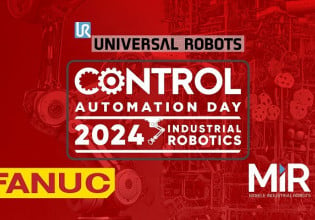Grippers vs. Suction Cups: Choosing the Right End-of-Arm Tooling
Knowing the difference between the various robotic grippers available makes selecting the most appropriate solution for an automation project less daunting.
Manufacturers can use several robotic grippers to automate their processes, each with its own set of advantages and limitations. However, finding the ideal solution depends on several factors, such as the tasks that are being automated, the environmental conditions, and the budget.
This article will begin by providing insights into grippers and suction cups. We will follow that up with a review of important factors to consider when selecting End-of-Arm Tooling (EoAT).

Figure 1. The End-of-Arm Tooling battle of grippers versus suction cups. Images of gripper and suction cups used courtesy of Adobe
Pros and Cons of Grippers
Grippers are one common component used in End-of-Arm Tooling. These devices enable robots to interact with objects of varying geometry and material composition. Due to the massive differences in the objects these grippers can interact with, they are used in a wide range of applications.
You will find grippers with two or three fingers; many are engineered to emulate the general anatomy of a human hand. The pros and cons of grippers depend on the type of gripper being used. Let’s review a few common gripper designs.
Parallel Two-Finger Grippers
Parallel two-finger grippers provide excellent stability. The 2-jaw design of these grippers makes it easier to automate processes as the part or component will always be between the two fingers or jaws. However, they have limited ability to handle irregular shapes or sizes.

Figure 2. A robotic arm equipped with a 2-jaw parallel gripper. Image used courtesy of Unsplash
Parallel Three-Finger Grippers
Due to their self-centering design, parallel three-finger grippers offer strong advantages in handling round or cylindrical objects. They can handle substantial payloads and, therefore, excel in heavy-duty tasks. A notable drawback is that unique applications may require different fingers or jaws.
Adaptive Grippers
Adaptive grippers are quite versatile. With multiple fingers made of flexible materials, they can easily grip irregular objects. The downside is that they tend to be less precise and operate at a slower pace. Additionally, they are susceptible to dirt and oil, which can affect their performance and durability over time.
Pros and Cons of Suction Cups
Suction cups are another essential component in End-of-Arm Tooling. Among the different types of robotic grippers on the market, suction cups stand out due to their versatility and low cost.
The EOAT may consist of a single suction cup or multiple cups that rely on a vacuum generated by the robot to lift objects. The vacuum lifts the parts and provides verification back to the program to ensure the object is present.
The pros of vacuum grippers and suction cups include:
- Vacuum grippers can handle a wide variety of objects ranging from small (like pieces of chocolate) to large (pallets of materials).
- They distribute the weight evenly across the surface of the object being lifted, preventing it from being damaged or deformed.
- They contribute to energy efficiency and noise reduction when equipped with self-closing valves.
- Their customizable nature allows manufacturers to change the number and position of suction cups, enabling them to handle a greater variety of objects.
- Their cost-effectiveness stands out among other gripper options, offering an economical solution without compromising functionality or efficiency.
The cons of vacuum grippers and suction cups include:
- They struggle to lift objects with highly porous or rough surfaces due to their reliance on an airtight seal.
- Irregular or curved objects may demand custom gripper designs or multiple suction cups for a secure hold.
- The rubber ring on suction cups wears out quickly, so they may require more maintenance and part replacement than other types of grippers.

Figure 3. A robotic arm equipped with suction cups. Image used courtesy of Unsplash
Factors to Consider When Selecting End-of-Arm Tooling
Selecting the ideal End-of-Arm Tooling solution for your application involves several key considerations. The first thing to keep in mind is the task that will need to be performed. The task determines the required speed and precision that the EoAT will need to be capable of.
For tasks demanding swift completion, a tool capable of fast and accurate movements becomes essential. Tasks that demand high precision require tooling with components capable of achieving such accuracy.
The frequency of task changes also influences the gripper selection. If tasks frequently vary, versatility needs to be considered, and the capability to adapt to different objects or scenarios without extensive reconfiguration becomes advantageous.
The operating environment must also be considered. For example, high temperatures may deteriorate the materials or components of the EOAT, leading to serious malfunctions or failures. Other environmental factors like dirt, dust, oil, or moisture can also affect the EOAT, causing corrosion, blockages, or disruptions to the intended movements within the robotic process.
Finally, cost is crucial when choosing an End-of-Arm Tool because it directly impacts the operation's overall financial feasibility and efficiency. Understanding the purchase, operating, maintenance, and energy costs will help you make an informed decision.
Final Thoughts
End-of-Arm Tooling comes in a variety of shapes and sizes. They can utilize an array of differing components, but the final decision will depend on your specific business needs and requirements.
Parallel two-finger grippers are ideal for stability and easy automation. Parallel three-finger grippers are the best choice for handling round or cylindrical objects, and adaptive grippers are the best solution for manipulating irregular objects.
On the other hand, vacuum cups integrated into the EOAT offer a cost-effective solution for handling light or heavy objects that do not have highly porous surfaces.
If you would like to learn more or get assistance in selecting the right tooling for your automation project, contact us, the company with the funny name, >ASS< End of Arm Tooling, Inc.






